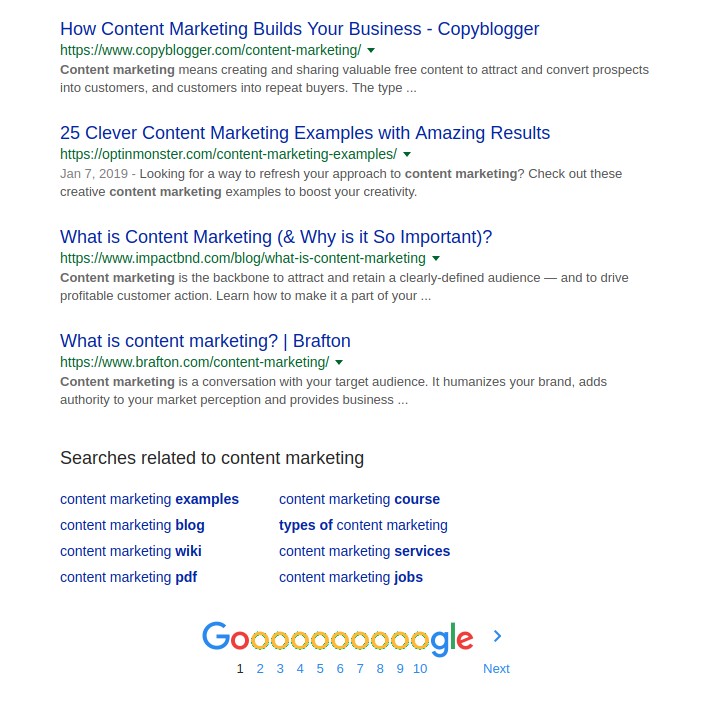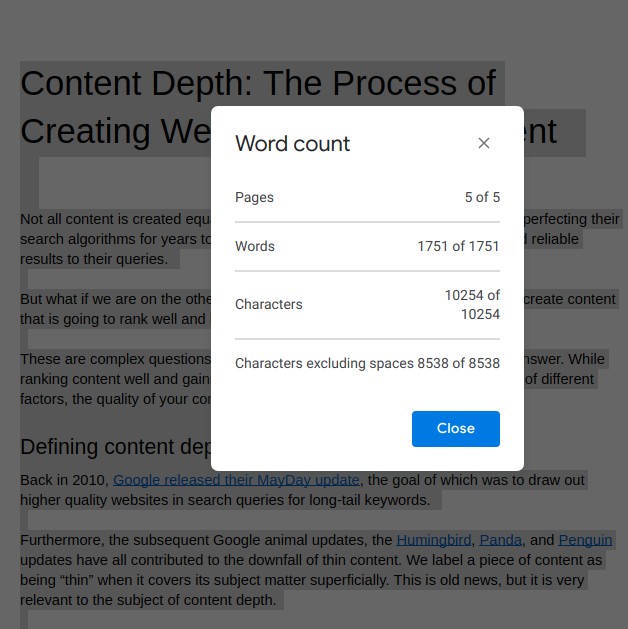Not all content is created equal. Google and other search engines have been perfecting their search algorithms for years to provide users with the most comprehensive and reliable results to their queries.
But what if we are on the other side of the search engine? What if we want to create content that is going to rank well and bring traffic to our website?
These are complex questions and we’d like to present you with a part of the answer. While ranking content well and gaining organic traffic is a process that involves a lot of different factors, the quality of your content is the most essential one – this is why well-researched content is crucial.
Defining content depth
Back in 2010, Google released their MayDay update, the goal of which was to draw out higher quality websites in search queries for long-tail keywords.
Furthermore, the subsequent Google animal updates, the Humingbird, Panda, and Penguin updates have all contributed to the downfall of thin content. We label a piece of content as being “thin” when it covers its subject matter superficially. This is old news, but it is very relevant to the subject of content depth.
This means that ever since 2010, content depth has been a major ranking factor, but what makes a particular piece of content in-depth?
Well, most usually, content is built upon a set of keywords which are currently in-demand and are relevant for the business or organization putting out the content. These keywords can be extremely limiting and usually don’t cover the topical broadness that Google can assign to a well-researched piece of content.
Meanwhile, Google has become very sophisticated at figuring out the contextual and semantical meaning behind user queries.

What you are seeing in the screenshot above are semantically related searches which Google routinely displays at the bottom of your first page of results. You can easily compare these with those “people who bought this item also bought” suggestions that are now so popular in online shops.
Creating content that covers more than a few of these related searches will improve your chances to rank on more than one popular search but we shouldn’t be looking at this in such a “robotic” manner.
Basically, Google’s goal is to boost content that answers the direct query, but also any important related questions to that subject matter. They want us to create content that provides the users with specific answers but also with as much of the “bigger picture” as possible.
It is quite possible to rank a single, in-depth piece of content for multiple queries and rank it better than creating numerous short-form content pieces to target them individually.
In-depth vs Long-form content

It is widely known that Google ranks longer content higher than short content. Still, content length and content depth are not the same – not by a long-shot.
There are a lot of articles out there that deal with the same subject matter, have the same (or nearly the same) word count but their rank is not even close.
Still, content length is a factor in creating in-depth content but it wouldn’t be right to assume that that’s all it takes to create in-depth content. Fluff is fluff, no matter how big your word count is and Google is getting better and better at identifying fluffy content.
Furthermore, according to OkDork and their 100 million articles analysis, articles that are below 1000 words are sixteen times more numerous than those that surpass the 2000 wordmark.
This only makes sense, as shorter content is less costly and takes less time to produce but it also tells us that, if we want to improve our contents’ chances to rank high, we need to make it longer.
They’ve also concluded that longer-form articles get radically more shares. Longer content is seen by users to be indicative of better resource quality and due to that, it gains credibility.
Still, it is worth noting that there is a limit to how far content length can take your content. Niel Patel covered this subject thoroughly providing his own content as an example. He gives a year by year analysis of his experimentation with content length and the results he managed to rack up.
This was his conclusion about articles that surpass the 10,000-word mark: “They are still in-depth, but I found that after 10,000 or so words there are diminishing returns.”
In my experience, content length should be decided based on the subject you are attempting to cover. But, if I had to define a content length sweet spot, I’d say that it stands somewhere between 1600 and 2500 words.
Advanced research

Most content these days is well-written, meaning that it is grammatically correct, its style and voice are on point, and the form is decent. However, when it comes to research and the density of information, most of these pieces will fall short. The reason for this has to do with the amount of research that goes into them.
Most experienced content writers will tell you that writing a piece is not a big deal – researching and understanding the subject matter is what makes up the majority of the writing process.
We’re going to outline some of the best practices that seasoned writers use to research a complex subject and find credible information to base their content on:
1. The primary source
When we are searching for information to base our article on, we run into many different sources along the way. The most common mistake made by authors around the world is taking all that information they find for granted.
In a lot of cases blogs, news portals, and other sources provide a piece of information by referring to a primary source. Inexperienced writers will just reference the secondary source without even taking a look at the original, which can jeopardize the credibility of the information used.
Humans are fallible and secondary sources may misquote a piece of information, take it out of context, or jeopardize its integrity in some other way. Furthermore, the primary source may not be as reliable as you have been led to believe by the secondary source.
Not all studies and statistics have been done by using the best practices proposed by the scientific method and you might want to check them out before you use them as a cornerstone for your content.
2. Rely on niche authority sources

One of the biggest challenges for writers working in a niche they haven’t covered before is identifying reliable and credible sources to draw information from. Both search engines and users view articles that cite seasoned authors, authority publications, and institutions as higher quality content.
How do you find reliable sources if you don’t have much knowledge about the niche you are currently covering? Well, this isn’t that hard actually. There are a lot of round-up articles out there which cover relevant publications, experts, and institutions for any particular niche. This is a good starting point.
3. Information freshness
When we are creating a piece of content, we want it to be based on the most recent findings and facts. How far back we go in our search for information depends on the subject we are covering, but we still want to ensure that the sources we use are still relevant at the time of the content being published.
Let’s say that we want to write a piece about “content writing” and we start doing our research. We can easily run into articles, whitepapers, studies from 5-10 years ago which were relevant at the time of their publishing.
However, content writing has evolved beyond recognition since then and we can’t rely on these old studies as relevant sources for covering this particular subject today.
Still, you should use common sense in these situations, as not every subject matter that we cover will be subject to as much change as our example, but the important thing is not to fall into the trap of going for a source that is outdated.
4. Wikipedia is a starting point

Every writer has relied on Wikipedia at one point or another. This online encyclopedia is very useful to familiarize with a subject you don’t know enough about. Wiki pages are useful in many ways. You can skim through to get a general idea about the topic, find various sources, dot down the basics, and so on.
S
I really hate it when people say that you shouldn’t use Wikipedia when doing research. You should, but it should be a starting point for your research, not the totality of it.
5. Learn to use Google
While Google is becoming more and more proficient at discerning our intentions and the meaning of our queries based on the context, it is still some time away from actually reading our minds.
This means that we need to know how to communicate our queries well and, while the Google search engine may seem simple to a casual user, writers need to be aware of and able to use Google’s advanced features.
We are not going to even attempt to list all the ways you can hone a search by using Google, and we are not even going to claim that all these features will be useful to you. Still, being able to narrow down your search and communicate what kind of information you are going to get increases the chances of getting better results to your queries.
Conclusion
Creating content that has depth is a complex process and one that takes time. Sure, specialized authors may be able to create a high-quality piece of content in a matter of hours, but they will be able to do so only when they are familiar with the subject, know all the relevant sources, and all they need to do is put a concept together and write it.
If you are after quality and want to create true value for the people who land on your article, you’ll have to show attention to detail and create a piece that is built on facts. Otherwise, you’ll end up with an SEO article most people will spend 5 to 10 seconds scanning before they hit that back button.
